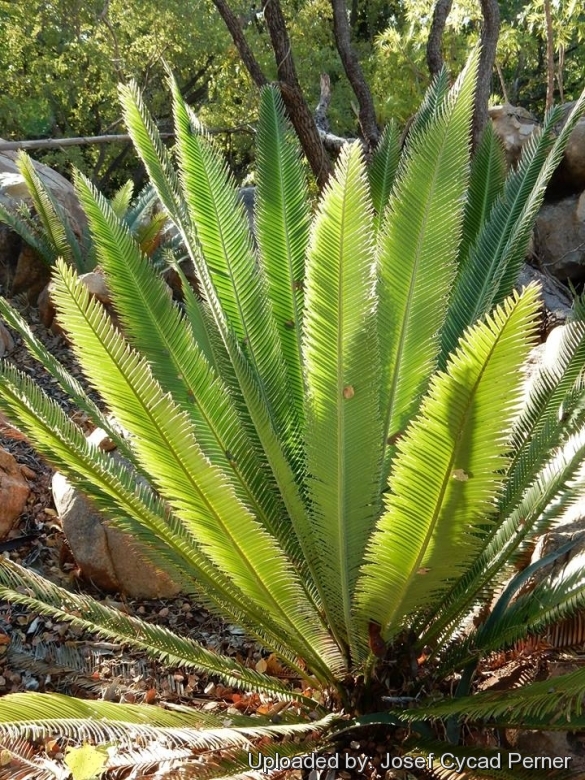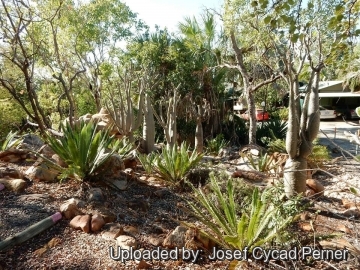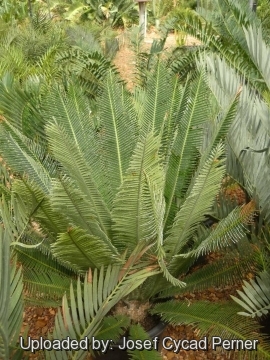




Your support is critical to our success.

Josef Cycad Perner private garden.
Origin and Habitat: Dioon merolaeSN|18074]]SN|18074]] is known from at fewer than ten locations in Chiapas (Distrito de Tonalá)and Oaxaca, in the southern part of Mexico.
Altitude range: 600-1200 metres above sea level.
Habitat and Ecology: Plants occur in a forest dominated by Pinus and Quercus and also in tropical semi decidious forest with soils developed on sedimentary rocks and karst limestone. Specimens are found growing on steep sandstone cliffs, along thickly vegetated watercourses. It is considered threatened in the wild. Populations are affected by over collection. In some cases the top portion of plants are cut off and sold as a table decoration.
Synonyms:
- Dioon merolae De Luca, Sabato & Vázq.Torres
- Dioon edule var. merolae (De Luca, Sabato & Vázq.Torres) Nance
SPANISH (Español): Yerba sagrada, Maíz viejo, Morrito, Palma espinuda, Palmilla, Espadaña
Description: Dioon merolaeSN|18074]]SN|18074]] is a medium-sized, arborescent and usually unbranched cycad species mimicking the look of short palm trees that recline with age. It show well developed aerial stems growing in habitat up to 6 m in length over centuries. In a garden this plant rarely exceed 2 m of height with a 2 metres leaf spread. Its leaves, fuzzy when immature, are dark green and stiff when mature. Primeval cycads like this Dioon merolaeSN|18074]]SN|18074]] are some of the oldest plants still living on the planet that trace their origins back to the ancient flora of the early Mesozoic era more than 170 million years ago. It is dioecious - it takes two plants to produce viable seeds.
Distinguishing characteristics: The most The most distinguishing feature for this species is its imbricate leaflets; they are joined to the rachis with the upperedge of the leaflet inclined upwards so that they resemble 'open venetian blinds'. The leaflets also overlap slightly and are toothed at the margins.
Stem (caudex): Generally a single up to 3-6 m tall, slender, columnar, erect or leaning with age, clothed with petiole scars.
Crown: The fronds radiate out from the trunk and grow in an upright manner.
Foliage: It has pinnate leaves that grow to about 80–100 cm in length. Leaflets 200-240 linear-lanceolate, 7–9 cm long, leathery, bright green, with thorns on the margins (opposing leaflets inserted at 50° on rachis). Basal leaflets not gradually reducing to spines.
Male cones: Spindle shaped, grey-brown 30-40 cm long, 8-10 cm in diameter.
Female cones: Female plants produce very large ovoidal cones on an elongated peduncle, reaching 40-45 cm in length, 20-25 cm in width.
Seeds: Cream to white, oval shaped and approximately 30–40 mm long.
Bibliography: Major references and further lectures
1) Keith Boyer “Palms and Cycads Beyond the Tropics: A Guide to Growing Cold-hardy Species” Publication Fund, Palm & Cycad Societies of Australia, 1992
2) Chemnick, J. & Gregory, T. 2010. Dioon merolae. The IUCN “Red List of Threatened Species” Version 2014.1. <www.iucnredlist.org>. Downloaded on 22 July 2014.
3) Whitelock, Loran M., “The Cycads” Timber press, 2002
4) Norstog, K.J. & Nichols, T.J. “The biology of the cycads.” Cornell University Press 1997
5) Tom Broome “Dioon merolae” The Cycad Newsletter 30(1): 10. March 2007
6) Charlie Beck “Growing Dioon merolae in Palm Bech County” http://www.palmbeachpalmcycadsociety.com/cycads/documents/DioonMerolae.pdf
7) Dioon merolae De Luca, Sabato & Vázq.Torres “DIOON MEROLAE (ZAMIACEAE), A NEW SPECIES FROM MEXICO” Brittonia 33: 180 1981.

Dioon merolae. In the background Pachypodium lealei and Livistona rigida. Josef Cycad Perner private garden. Photo by: Josef Cycad Perner

Dioon merolae Photo by: Josef Cycad Perner
Cultivation and Propagation: Dioon merolae is a very adaptable plant well suited to warm temperate and subtropical climates. It is long lived and slow to moderately fast growing and a plant with 30 cm of stem can be quite old (10-20 or more years). However, in cultivation, a plant with decimetres of trunk is fairly old and considered a specimen. This is a frost-tolerant, heat-tolerant and sun-tolerant species.
Soils: It prefer well drained, gritty soil with plenty of water, especially in dry weather.
Fertilization: Naturally undemanding for nutrients, it responds very well to regular applications of fertilizer. Growth can be greatly improved through the application of fertilizers. Most growers find that a fertilizer having an even NPK (Nitrogen, Phosphorus, Potassium) balance, and supplemental trace elements, provides a good start for cycads.
Exposure: It thrives and grows best in partial shade.
Waterings: In cultivation prefers moist soil with good drainage for optimal growth. But it is eventually very drought resistant.
Hardiness: Mature and established plants have been reported to tolerate light frosts for some days.
Propagation: This species may be propagated by seeds or by division and replanting of the attractive offsets or "pups" formed at the base of the oldest plant. They are among the easiest plants to germinate. The seeds are about a large grape size and hard as a rock.
Uses: The leaves (fronds) were used for decoration, especially in religious ceremonies.
Warning: The leaflets of dioon taper to a sharp point. It is well advised to plant virgin's palm away from footpaths and walkways. Wear heavy gloves when handling or working close to the plant to avoid getting jabbed by the sharp points of the leaflets.
| Your Actions | |
|---|---|
| Back to Dioon index | |
| Back to Zamiaceae index | |
 |
Back to Palms And Cycads Encyclopedia index |
Privacy stantement - Terms and conditions - How to cite - About us - Feedback - Donate


